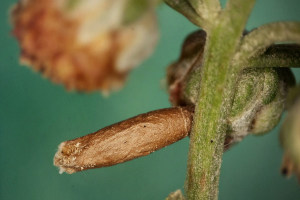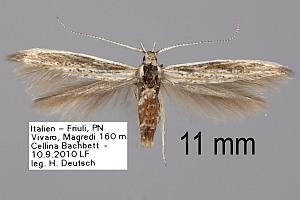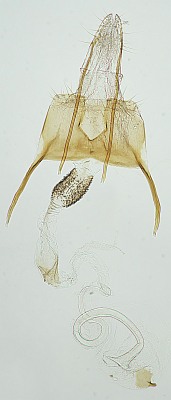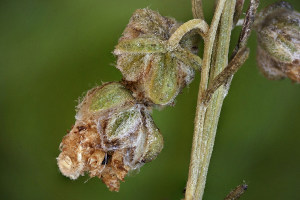

 +6Kontinente:EU
+6Kontinente:EU2. Diagnose
2.1. Weibchen
2.2. Genitalien
2.2.1. Weibchen
3. Biologie
3.1. Nahrung der Raupe
- [Asteraceae:] Artemisia alba [= Artemisia camphorata] (Kempfer-Wermut, Kampfer-Edelraute, Cola-Strauch)
Die Nahrung der Raupe war lange unklar. Takács et al. (2022) fanden dann zahlreiche Raupen in Ungarn an Artemisia alba bzw. Artemisia alba subsp. canescens, die Bestimmung wurde durch Barcoding von Raupen und durch Zucht zum Falter abgesichert. Die Autoren berichten detailliert über die Larvalbiologie: "Initial case is made of a dry inflorescence of A. alba. The larva consumes the centre of the inflorescence, remaining parts are strengthened with silk (Fig. 12) and thus the remains of the inflorescence retain their original shape. Depending on its size, up to three or four larvae can feed on the same individual plant. Several inflorescences are consumed in the protection of this case, then the larva in L4 stage prepares a tubular silk case beneath the older one. Later on, the achaenia fall off from the tubular case (Figs 13, 14), and the larva seeks a still intact inflorescence, attaches the case to it, chews itself inside the inflorescence, and performs its last moult in this shelter. Finally, it descends to the base of the host plant and attaches its case to it."
4. Weitere Informationen
4.1. Etymologie (Namenserklärung)
Die Art ist nach dem locus typicus Monti Lessini benannt.
4.2. Faunistik
Richter (2017) teilt mit: "Rare species with scattered distribution in Europe with records from France, Italy, Hungary, Croatia and Macedonia. New species for Bulgaria".
Durch die gezielte Raupensack-Suche gelangen Takács et al. (2022) in Ungarn deutlich mehr Funde als bisher. Sie kommen zum Schluss: "We were able to collect C. lessinica specimens from every location where its host plant, Artemisia alba is known to occur in Hungary. This implies that the species is more widespread than the published records suggest. To clarify the distribution of the species the host plant populations should be investigated during the flowering period."
(Autor: Erwin Rennwald)
4.3. Typenmaterial
Baldizzone (1980: 234): « Holotype ♂ (PG Bldz 2763) : « Verona, Monti Lessini, Trezzolano, 400 m, 1-IX-1978, P. Triberti leg. », coll. Baldizzone, Asti.
Allotype ♀, idem, coll. Baldizzone.
Paratypes : 3 ♀♀, idem (2 expl. in coll. Baldizzone, 1 expl. in coll. Triberti, Verona).
2 ♀♀ (PG Bldz 2756), idem, 8-IX-1978, Triberti leg., coll. Baldizzone.
1 ♂ (PG Bldz 1908), 1 ♀ (PG Bldz 1917), « Emilia. Montebaranzone (Prignano sulla Secchia). Modena, 557 m, 25-VIII-1968, U. Parenti leg. », coll. Baldizzone.
1 ♂ (PG Bldz 3058) 1 ♀ (PG Bldz 3064), « YU-Maced. occ. Mt. Asan Djura, 1100 m (Prespa), 5-VIII-79, Lux, leg. Baldizzone », coll. Baldizzone. »
4.4. Literatur
- Erstbeschreibung: Baldizzone, G. (1980): Contributions à la connaissance des Coleophoridae, XVIII. Description de deux espèces nouvelles du genre Coleophora Hübner : C. pyrenaica n. sp. et C. lessinica n. sp. — Alexanor 11 (5): 232-234, pl. LI-LIV.
- Richter, I. (2017): New findings of the case-bearing moth genus Coleophora from the Balkan Peninsula with the description of Coleophora vardarella sp. nov. (Lepidoptera: Coleophoridae). — Microlepidoptera.hu, 12: 83-94. [PDF auf oszk.hu] bzw. [ganzes Heft: PDF auf oszk.hu]
- Richter, I. & G. Baldizzone (2025): New faunistic and biological records on Coleophoridae from the Balkans (Lepidoptera). — Lepidopterologica Hungarica 21: 27-39.
- Takács, A., Szabóky, C., Boldog, G., Jordán, S., Bozsó, M., Fülöp, D. & B. Tóth (2022): Biology and DNA barcode analysis of Coleophora lessinica Baldizzone, 1980 and Coleophora impalella Toll, 1961 (Lepidoptera, Coleophoridae) with description of their larval cases. — Nota Lepidopterologica, 45: 191–205. DOI 10.3897/nl.45.80106. [zum open-access-Artikel auf pensoft.net] bzw. zum [PDF-Download auf researchgate.net]












